

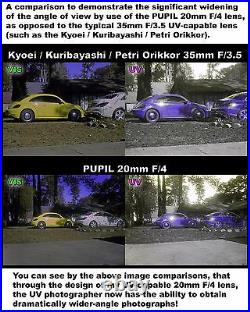
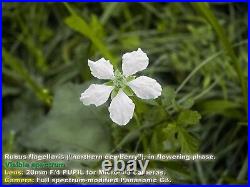
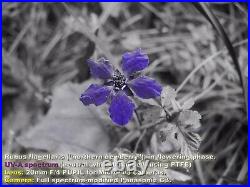

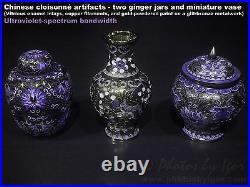
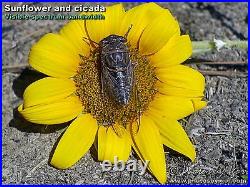
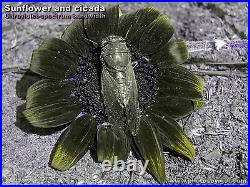
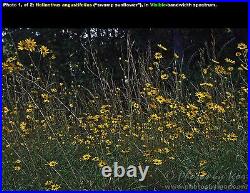



This lens was fondly named the P. " due to the fact that the acronym stands for "Prime UV Pancake Instant Landscape. NOTE: This is my GEN-IV (fourth generation) lens model, with an even wider-angle focal length of 20mm and a brighter, faster aperture of F/4 (as opposed to my GEN-III lens model with a 23mm focal length and an aperture of F/6).
A deeply-recessed front element, which makes this lens highly resistant to flaring even without the use of an additional hood for protection. A generous focus-throw range, which permits focusing all the way from infinity to just 6 from the subject, resulting in a roughly 1:3 macro-magnification. Very deep UV transmission, down to about 330 nanometers, which is comparable to the UV performance of the very rare Kyoei Kuribayashi and Novoflex Noflexar 35mm F/3.5 lenses. Designed with the goal of making ultraviolet photography more accessible and economical, especially for those on a limited budget.
A 20mm focal length (equivalent to 40mm on the 2x crop-factor sensor of a Panasonic or Olympus Micro-4/3 camera), although this is still much wider than virtually any other UV-capable lenses out there, thus making it suitable for ultraviolet photography of landscapes. Manual-focus only to keep cost down and remain budget-friendly for all buyers. Finally, the ultraviolet photographer community now has access to a wider-angle lens that can equally handle UV-landscape photo projects and UV-macro photo projects in one simple, compact, no-nonsense design. And through a BUDGET-FRIENDLY offering, at that! A QUICK DEMONSTRATION OF THIS LENS'S INCREDIBLE FOCUSING RANGE.
Please observe the animation clip below, demonstrating the lens's entire focus-throw length - from the pancake-like compactness of its infinity-focus position, all the way to just 6 (152 mm) from your subject at its fully-extended position - for nearly a 1:3 macro magnification! If I were to design this lens to have the front barrel focus any closer to your subject than this, it would be casting shadows on your subject. So, this is about as close as I'd prefer to have this lens focus, and I would say that it's plenty close enough. NOTE : NO CAMERA IS INCLUDED IN THIS SALE.
THIS IS SIMPLY SHOWN FOR DEMONSTRATION PURPOSES. MORE INFORMATION (FOR THOSE "INQUIRING MINDS"). This is an original, custom-built (hand-made and assembled piece by piece) pancake UV-capable lens, specially designed to be used with a full-spectrum-modified camera and proper filter stacking to elicit the desired transmission and associated images. It is a highly-versatile UV lens, at that, given the fact that it can be focused from infinity to just about 1:3 macro (6 or 152 mm from subject), all in one compact and light package!
While the entire body of the lens body is assembled from brand new and nearly all-metal parts fabricated and fitted to precision, the actual "lens capsule" in itself (where the lens glass is seated) is derived from re-purposed elements scavenged from various vintage parts, and thus the entire developmental stage of this UV-photographic project has been born out of painstaking calibration and testing in order to finally come up with this sale-ready goal! In other words, this UV lens is a fascinating melding of vintage and new parts, combined into one functional unit. I ENJOY re-purposing vintage glass and giving it a new lease on life, rather than sadly seeing it being sent off to the landfill. Being as such, there may be some very minor imperfections attributed to the assembly of vintage glass elements, such as a handful of insignificant and unavoidable tiny dust particles which may on occasion become trapped in between the glass elements. However, these factors have no discernible effect on image quality nor UV transmission, whatsoever.
Even in more modern lenses, this is not uncommon. Nonetheless, each individually hand-crafted and assembled lens is meticulously field-tested for any potential issues before even being considered viable for use and sale. I will NOT "half-ass" such projects, as budget-minded and cost-effective as they are. No fuss, no drama, no hostility. WHAT IS THE OPTICAL FORMULA OF THE LENS? The glass elements implemented in the construction of this UV lens are based upon a "Tessar" optical formula (4 elements / 3 groups). After years of experimentation with various optical configurations from piles of salvaged and re-purposed photographic parts, I have stumbled upon one of the more sought-after wishes of a UV photographer: A wider-angle UV-capable lens with surprisingly useful UV transmission down to about 330nm or so! These facts were corroborated by using various narrow-bandpass filters set in an array for testing transmission depth, which is the "poor man's spectrometer" test, in a manner of speaking. That's quite a surprise, and the "UV-colors" appear nearly identical in saturation in comparison shots between my 20mm UV lens and the highly-sought Kyoei / Kuribayashi 35mm F/3.5 lens, when white-balanced to a UV-neutral target such as PTFE / white Teflon.
ONCE AGAIN, PLEASE NOTE : On the 2x crop-factor sensor of a Panasonic or Olympus Micro-4/3 camera, this 20mm lens effectively becomes a 40mm lens. Still, as stated in my ad title, this is much wider than the Kyoei / Kuribayashi and Novoflex Noflexar 35mm UV-capable lenses (given that a 35mm lens becomes a 70mm-equivalent lens on the same camera). Hence, going from an equivalent 70mm to 40mm of focal length is undoubtedly a substantial widening of the angle of view. Therefore, I would definitely say that being able to use a resulting 40mm focal-length lens for deriving useful UV-landscapes and UV-macro photographs, alike, is certainly approaching into "wider" territory, compared to the majority of previously-implemented UV-capable lenses on the Micro-Four-Thirds sensor format.
WHY WAS THIS LENS DESIGNED WITH A FIXED APERTURE OF F/4? To keep production costs down (thus, retaining this lens's budget-friendly price offering), I decided to go with a fixed-aperture design. But why the choice of F/4, and not F/2.8 or faster? The answer is quite simple. An aperture of F/4 still falls within the lower end of this lens's "sharpness sweet spot" (producing more consistent sharpness across most of the image circle), while still being conservative enough of a stop-down decision to keep this lens from becoming too dark. I could have certainly aimed for a "faster" design, but in order to balance all of the attributes (strengths and weaknesses) of the design concept, I made my choice to fix the aperture at F/4 because this affords far more advantages than drawbacks, compared to all other aperture ranges. Some of these other advantages (besides optimized sharpness) include.
Sufficiently available DOF (depth-of-field) when the lens is focused down to its highest-magnification macro-focusing extension. (A fixed aperture of F/2.8 or faster would certainly let in more light at infinity-focus, but this would introduce a prohibitively shallow DOF at the macro end of the focusing range). Additionally, of course, a fixed-aperture of F/2.8 or faster would produce softer image rendering across the entire focus-throw range. Minimizing "focus-shift" phenomenon when switching between VISIBLE-spectrum photo-taking and UV-spectrum photo-taking. This can satisfyingly reduce the tedious workflow of taking comparison VISIBLE / UV photos while in the field, by minimizing the requirement to perform drastic "re-focusing" of the subject between snapping VISIBLE and UV photographs.
However, for a budget-minded lens such as this one, my choice to go with a fixed-aperture of F/4 essentially makes this optical phenomenon a minor aspect of the photo-taking process due to it being more easily compensated for. This is a "pancake" (ultra-compact and light) lens design concept, after all. But a "faster" aperture would have made this lens less compact, because of necessitating for a larger and heavier tube construction to obtain the same generous focus-throw ability between infinity-focus and 1:3 macro, as well as adequately correct for the resulting optical phenomena. A fixed-aperture design of F/8 would have undoubtedly made this lens even sharper , of course, but now we would finally begin to see some of the disadvantages creeping in (including an encroaching darker image, even in brighter light), hence my choice to balance all attributes by going with a middle-of-the-road F/4 design. Even when it comes to UV lenses which are constructed with variable aperture-selection capabilities (those that have adjustable aperture blades), nearly all archival / institutional-grade UV photographs are taken with a stopped-down aperture, anyway!
(Typically between F/5.6 and F/8, depending on the specific photo-taking scenario, for improved edge-to-edge image quality results). Thus, you see that there is nothing particularly "limiting" about having me construct a UV lens with a fixed-aperture design of F/4, right at the onset, while still remaining relatively on the "faster" side (conservative-minded) of the stop-down decision with the fixed-aperture construction. BUT HOW GOOD IS THE ACTUAL IMAGE QUALITY? For a Tessar (4-element) optical design, I'd say that the image results are sufficiently sharp and quite usable (especially within the center of the image frame), with gradual sharpness drop-off (moderate softening) towards the edges of the image frame (which is common for most lenses of a simple optical formula, anyway).
This edge-softening, however, is only more apparent with infinity-focus photographs (photography of landscapes), but begins to decrease when working with macro-focusing photographs (photography of closer subjects). Actually, with closer-focusing use of this lens (such as UV photography of flowers), I have not encountered notable edge-softness.
Indeed, this lens obtains surprisingly useful images, given its versatility! There is nothing to complain about, and you will be pleasantly surprised with its overall performance versus price. In fact, according to well-established optical theory, an optimally-constructed triplet (Cooke) lens is the simplest-possible optical design that is capable of correcting all of the seven Seidel aberrations over a wide field of view. Hence, my idea was to design a lens using the LEAST amount of glass possible, in order to maximize on UV transmission, without extremely compromising on image quality (aside from the corner-softening of the image frame at infinity-focus, which is the only substantial consequence). Meaning that although my 20mm lens is wider-angle than my 23mm lens and also "faster" (at F/4), the 23mm lens offering is sharper along the edges at infinity-focus (given its smaller fixed aperture of F/6). I therefore leave it up to you, concerning selection of the lens which matches your greatest priorities. You can always contact me, to help you decide, if you remain unsure. Overall, I'll let the images in my ads speak for themselves, and you'd also have to experience my UV lenses for yourself to grasp how sufficiently well they perform, economically-speaking (price versus performance), despite being composed of a relatively "primitive" optical formula. TO BE SURE : Don't expect this lens to produce the same level of superb razor-sharp rendering across the entire frame like specialized quartz-fluorite glass with a more intricate optical formula that costs thousands of dollars more. Let's be realistic, here. However, for what it's worth... You'd be hard-pressed to find any other optical configuration (especially at such a wider focal length and very deep UV-transmission) that would nonetheless provide VERY USABLE results, indeed. The point is - we now have a wider-angle UV-capable lens for instant ultraviolet landscapes in a pinch , through a compact ("pancake") and no-frills build (easy to manually focus and highly resilient to flaring) that can certainly hold up to real-world demands... When all attributes are considered (price versus performance) and one's expectations are realistic and restrained. With those constraints kept in mind, t he 20mm F/4 P. Does respectably well for what it was intended to do, and THERE IS NO OTHER UV-CAPABLE LENS ON THE MARKET THAT IS QUITE LIKE IT , when factoring in the all-around balance and versatility of its design, capability, and cost. Thus, I think for the price-point, this lens is extraordinary with its overall value. To champion a more budget-friendly and accessible wider-angle lens to the UV community - especially newcomers to the game who do not want to "break the bank" just to get their feet wet. As you can see, I want to preserve my integrity, first-and-foremost, by being fully transparent with my dealings. And I feel that one of the more important convictions is to REFUSE to succumb to the temptation of price-gouging. Hence, in short, my modest and fair profit is simply made for the time that I put into making each lens.
I also pack each lens with the utmost care and protection in mind, padding the lens to shield it not only from the bumps and bruises of long-distance travel, but even complete sealing from moisture / humidity, too! I utilize air-tight packaging materials, and humidity-absorbing desiccant packets.
Thus, this is about as big of a bargain as you will get! You can therefore be certain that your investment is protected to the utmost level of care in mind. I don't mess around! As stated earlier, I want to be a fair and transparent individual in all of my dealings. Because supplies are currently limited, in themselves, and so is my current financial capital.
Maybe I'll fabricate a total of 20 to 30 lenses in all? For the time being, I have enough supplies to successfully put together only a handful of these at a time, in any given month. (But again, that may change, if this offering proves to be more popular than anticipated, and I continue to find additional components to keep making these indefinitely).
Still, the fact remains that - ultimately- this WILL be a limited production run when all is said and done, because the optical glass used in this design is NO LONGER BEING MANUFACTURED. So once the supplies are exhausted, they'll be gone forever. For added authenticity and a pinch of style: I have designated a serial-number labeling system for these hand-crafted and custom-tuned lenses. Serial # "MFT16001" was the very first sale-ready copy. For example: "MFT" refers to the Micro-Four-Thirds system that this UV lens for specifically designed for, and "16001" in this case being the numbering system which represents 2016 as the starting production year, and 001 as the lens count for that production year.
Sony E-Mount (formerly "NEX") APS-C. Fujifilm X series (X-mount) APS-C. Additionally, I have also heard some of your requests (those who have contacted me and/or have been in constant communication with me, regarding my ongoing experimentation and prototyping for other mirrorless camera systems), and I have also now successfully adapted this UV lens for the Canon EOS-M and Nikon-1 mirrorless camera platforms.
However, because of the additional technical hurdles which still need to be overcome when trying to adapt this lens to traditional DSLRs with larger FFDs (flange focus distances) and a flapping mirror, this has thus far been a challenge for me. But rest assured, that if my DSLR-adapted projects are a satisfying success (without any compromises) , I will accordingly put these UV lenses up for sale, as well. You will need a "full-spectrum-modified" camera, as well as specific types of optical filters (cut to proper thicknesses, no less), in order to make use of this lens for its dedicated purposes. Thus, it is implied that you are well-rounded and properly-trained in understanding how to obtain and implement such mandatory devices and accessories, in order to use this lens for UV-A photography. Granted, the 20mm F/4 "PUPIL" lens can take fairly-decent "normal" images, too. Given its exceptional UV-transmission depth, its "talents" would be wasted on any other use besides what its construction was specifically intended for. LET ME STRESS THIS ONE FINAL TIME: This particular custom-built UV lens is exclusively designed for the Micro-Four-Thirds mirrorless camera platform. Thus, it is your responsibility to be aware of this fact, as well. NEED ADDITIONAL HELP, OR HAVE ANY LINGERING QUESTIONS AND/OR COMMENTS?? I strongly recommend checking out ultravioletphotography-dot-com as a high-quality resource for all things UV (and IR) photography, including starter guides / tips (for newcomers), techniques and insights, common Q & A's, various discussion threads (where inquiries can also be posted), tons of incredible photographic examples and formal archives of various members, and many other useful resources!
Ask me, and I will give you additional info. I aim to make great new friends, and establish life-time contacts of mutual interests! However, I can refer you to those who are "seasoned veterans" of the game (who were there right from the very beginning), if you so wish it. The item "20mm F/4 UV lens for Micro 4/3 cameras! For ultraviolet photography" is in sale since Sunday, December 4, 2016.
- Color: Purple
- Brand: Featuring the all-original 20mm F/4 "P."
- Model: GEN-IV release
- Country/Region of Manufacture: United States

